Climbing Aconcagua: The Ultimate Guide (2023)
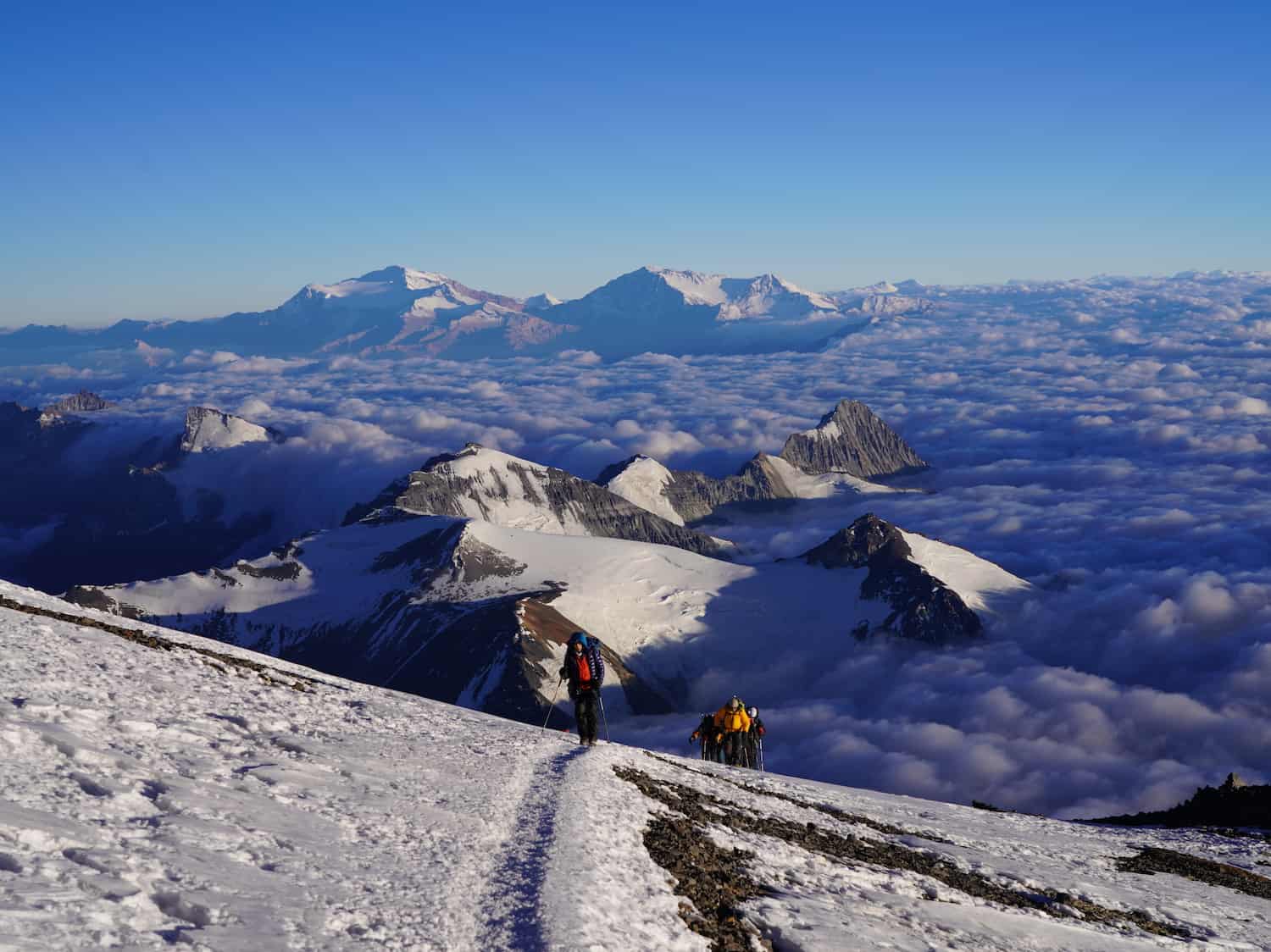
So you’re interested in climbing the tallest mountain in the Americas? Congratulations! A summit attempt on Mount Aconcagua (22,838 feet), is no small goal, and you should be proud of yourself for working towards it. If you succeed, it’s an accomplishment you can carry with you throughout your life.
I climbed this Argentinian behemoth for the first time just a few weeks ago, on February 3rd, 2023, and was surprised at how difficult it was. Even though I have a fair bit of experience in the mountains, including extensive technical climbing at lower elevations, Aconcagua was the highest peak I’ve summited to date, and I found it much more demanding than I had expected. 22,000 feet is no joke!
In this article, I’ll share everything you need to know for a successful summit of Aconcagua, based on my recent experiences on the mountain, as well as my 10+ year climbing career. Let’s dive in!

What’s So Special About Aconcagua?
Aconcagua is a unique mountain for a number of reasons. Located in the Principal Cordillera of the Central Andes, this mountain is the highest peak in South America, and one of the “Seven Summits.” But at a whopping 22,838 feet (6,961 meters), it’s not only the tallest mountain on the continent. It’s also the tallest mountain in the entire Americas, the tallest in the Western Hemisphere, the tallest in the Southern Hemisphere, and the tallest in the world outside of Asia.
Aconcagua’s summit is also unique because of its lack of technical difficulty. It is perhaps the highest mountain in the world that can be climbed without any technical gear or mountaineering experience. By the Normal Route, climbing Aconcagua is a walk-up. Under good conditions, you may not even need to use crampons or an ice axe to reach the summit, and even if there is significant snow on the mountain (like there was when I climbed it) there are no true “technical” sections on the entire route. (There are more technical routes, however, such as the Polish Glacier Route and the Polish Traverse Route.)

As such, an Aconcagua expedition is an excellent adventure for beginner mountaineers. It’s certainly a serious physical challenge, but it’s totally possible to climb Mount Aconcagua without much more than a strong pair of legs and lungs.
Fun Fact: The world’s highest-altitude art gallery is also located in Aconcagua Base Camp! Set up in a small tent at 14,300 feet, Miguel Doura’s “Nautilus” is home to over 100 paintings, mostly of Aconcagua and the surrounding mountains. The tent serves as his home and workshop for three to four months each year and is open to visitors free of charge. Doura sells paintings to climbers and other visitors to Base Camp, sleeping on a cot on the floor. His work has been displayed everywhere from the Netherlands to Russia. Despite his laidback demeanor (the guy lives in a tent!) his paintings have sold for upwards of $50,000!
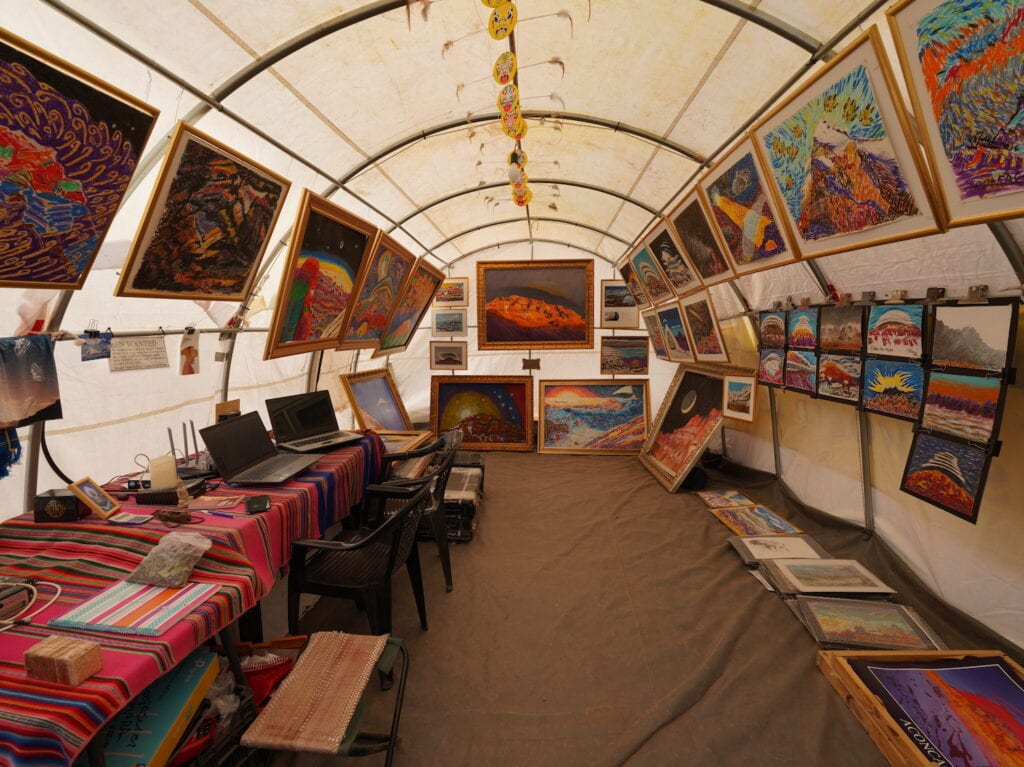
What to Expect
Although Aconcagua isn’t as technical or demanding as most other mountains around 7,000 meters in elevation, it’s a serious endeavor, and for most beginner climbers it’s the hardest mountain they’ve attempted in their career. Aconcagua is nearly 10,000 feet higher than any peak in the continental United States, like Whitney (14,505 feet) or Rainier (14,410 feet). As such, it’s unlikely that many climbers on Aconcagua will have prior experience at a similar elevation.
Even compared to other high-elevation trekking peaks like Mexico’s Pico de Orizaba (19,491 feet), or even other high Andean peaks like Ecuador’s Chimborazo (20,549 feet), which can both be ascended in two to four days, Aconcagua is in an entirely different universe. That’s because (as mentioned below) Aconcagua expeditions take nearly three weeks, and approximately 10 days or more are spent on the mountain proper, sleeping in tents at high elevations.
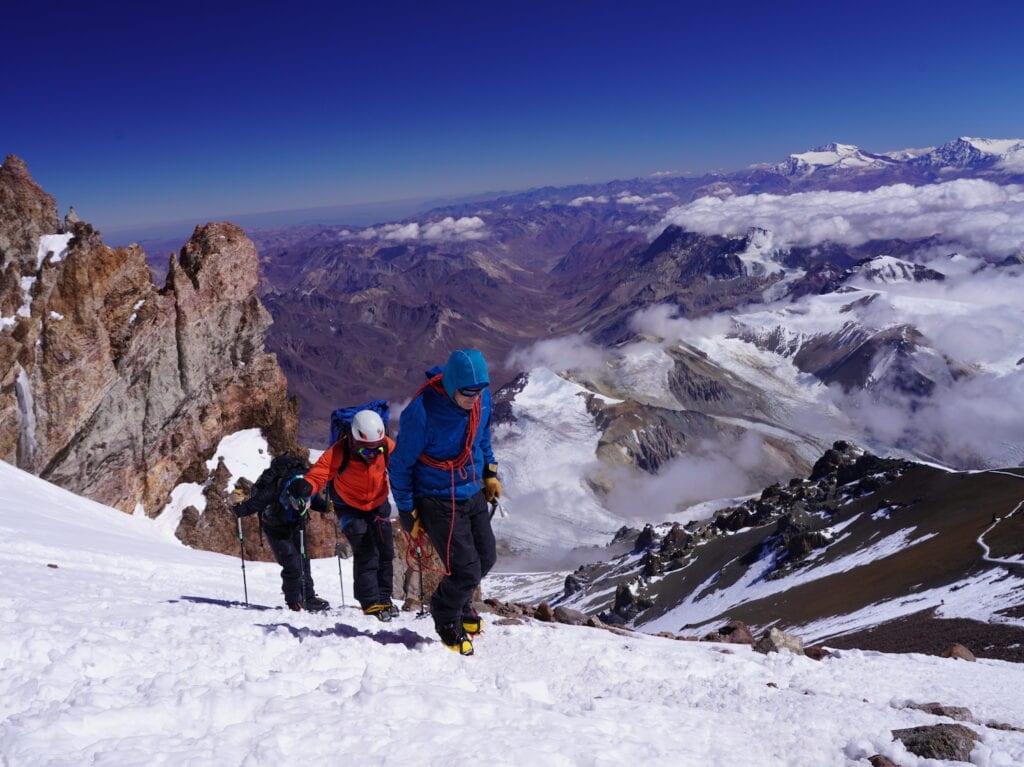
All told, on an Aconcagua expedition you should expect to spend over a week hiking up and down steep trails with heavy packs, sleeping and living at high elevations. Expedition life is something you’ll have to get used to for an extended period: boiling water, sleeping on cold ground, and eating dehydrated food. Expect sub-freezing temperatures, especially on the summit ridge, and high winds. Summit success doesn’t come without a bit of suffering!
Cost of Climbing Aconcagua
The cost of an Aconcagua expedition can range from $3,500 with a dirt-cheap outfitter all the way up to $18,000 with a high-end guiding service in the high season. There’s certainly no reason to pay much over $10,000, but you shouldn’t climb with tour operators offering rock-bottom prices, either.
Cheap outfitters are cheap for a reason. You run the risk of climbing with cheap gear and inexperienced guides. After all, climbing permit fees alone costs nearly $1,000. When you factor in food, hotels, gear, porters, possible medical expenses, and local guides, you begin to understand why most reliable climbing operators charge $6,000 to $8,000.
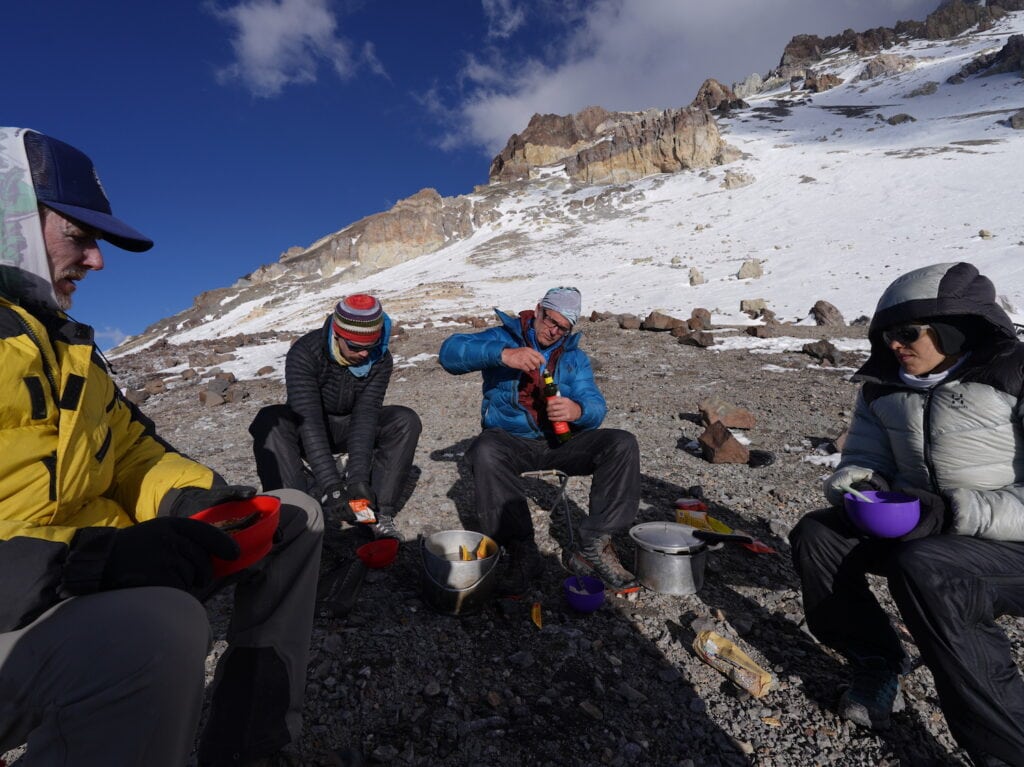
Anyone charging only a few thousand dollars for an Aconcagua climb is seriously cutting corners somewhere. With Benegas Brothers Expeditions (the boutique outfitter I used), prices start at $5,900 per person but vary depending on season and group size.
Tips for a Great Expedition
Training: How to Prepare for Climbing Mount Aconcagua
Cardio is key when it comes to any high altitude climbing. You’ll need excellent physical conditioning for summit success. Aerobic activities like swimming, running, and cycling are all stellar components of an Aconcagua training program. However, the core of your training plan for climbing Aconcagua should be long hiking days carrying a heavy pack.
Remember, you don’t need any technical climbing experience if you choose to ascend via the Normal Route (instead of the Polish Glacier on the other side of the mountain, or another line). But by the time you leave for Argentina, you should be able to easily complete a 12-hour day of steep hiking with a heavy pack. Be both physically AND mentally prepared for several days like this. Most days will be shorter, save for the summit push, but it’s better to be prepared for extra hiking. If one or more of your summit attempts are stymied due to bad weather, you’ll need to be in good shape for another attempt when the weather clears!
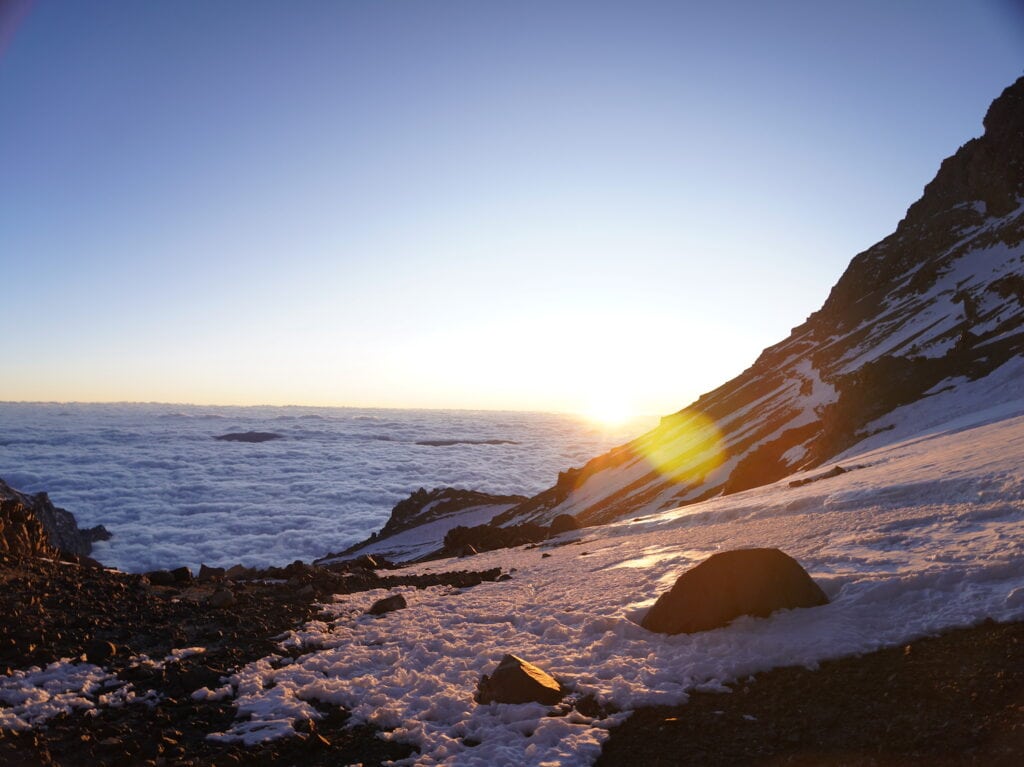
If possible, try to also complete at least one or two hiking trips at 4,000 meters or higher. This will help you understand how your body will perform at altitude because everyone is different. Practice proper hydration throughout these trips to prevent altitude sickness!
If you’re wondering how much weight you’ll have to carry to climb Mount Aconcagua, it’s best to overestimate. Anticipate 35 to 40 pounds. Your pack weight on the expedition will depend on the guide service you choose and your guide’s opinion, and it could very well be lower than this (as low as 15 or 20 pounds). But it always helps to train for your mountain experience with a heavier pack weight! When you’re up at 20,000 feet, you’ll appreciate this extra preparation.
The Gear You Need for Aconcagua
The following is a rough list of gear you will need for climbing Aconcagua. Keep in mind that certain outfitters will provide you with many of the items on this list, while others will require you to bring your own gear. Almost all Aconcagua gear can be rented in Mendoza before you begin your expedition, including apparel, but renting your own gear can get quite expensive, and stock is often depleted during peak season.
Please note that this list is by no means exhaustive, and does not include group equipment that will be shared between you and other climbers, such as tents, propane stoves, and fuel canisters.
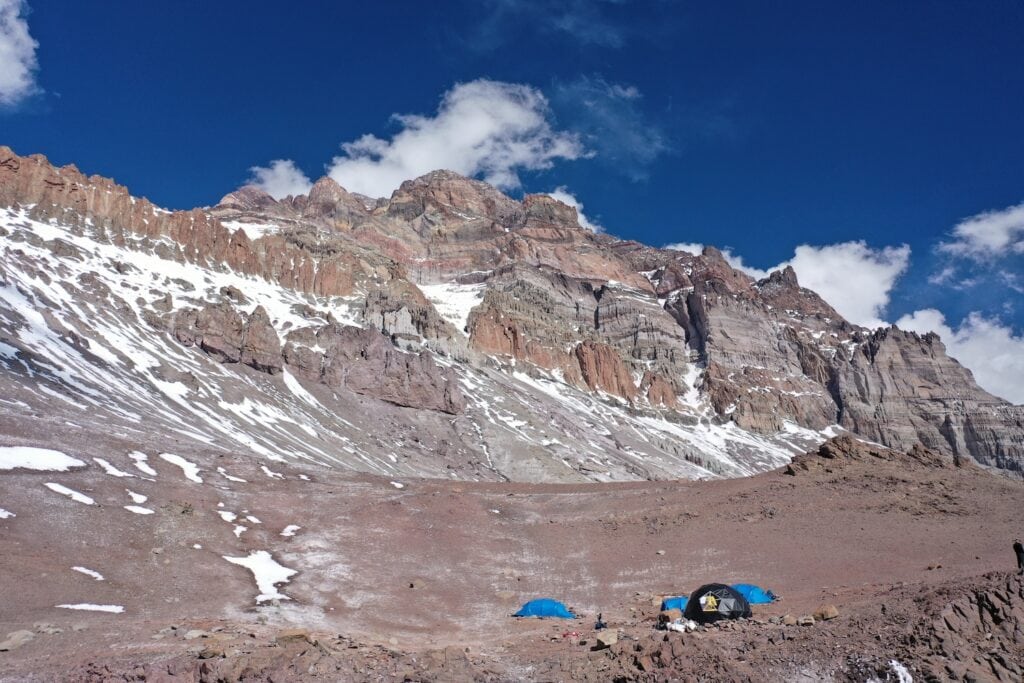
Climbing Equipment
- Ice Axe
- Crampons
- Helmet
- Harness
- Locking carabiner (1x)
- Trekking poles
- Glacier glasses
- Goggles
Apparel
- Buff
- Sun hat
- Balaclava Wool hat/beanie
- Liner gloves
- Warm, waterproof mountain gloves
- Down mittens
- Underwear (3x)
- Shorts Softshell pants & jacket
- Hard shell pants & jacket
- Expedition weight down parka
- Lightweight trekking pants (2x)
- Lightweight down jacket (easily compressible)
- Expedition weight thermal top & bottoms
- Ultralight, moisture-wicking base layer top & bottom
Sleeping Gear
- Sleeping bag (-20F)
- Sleeping pad (foam)
- Sleeping mattress
- Compression stuff sacks
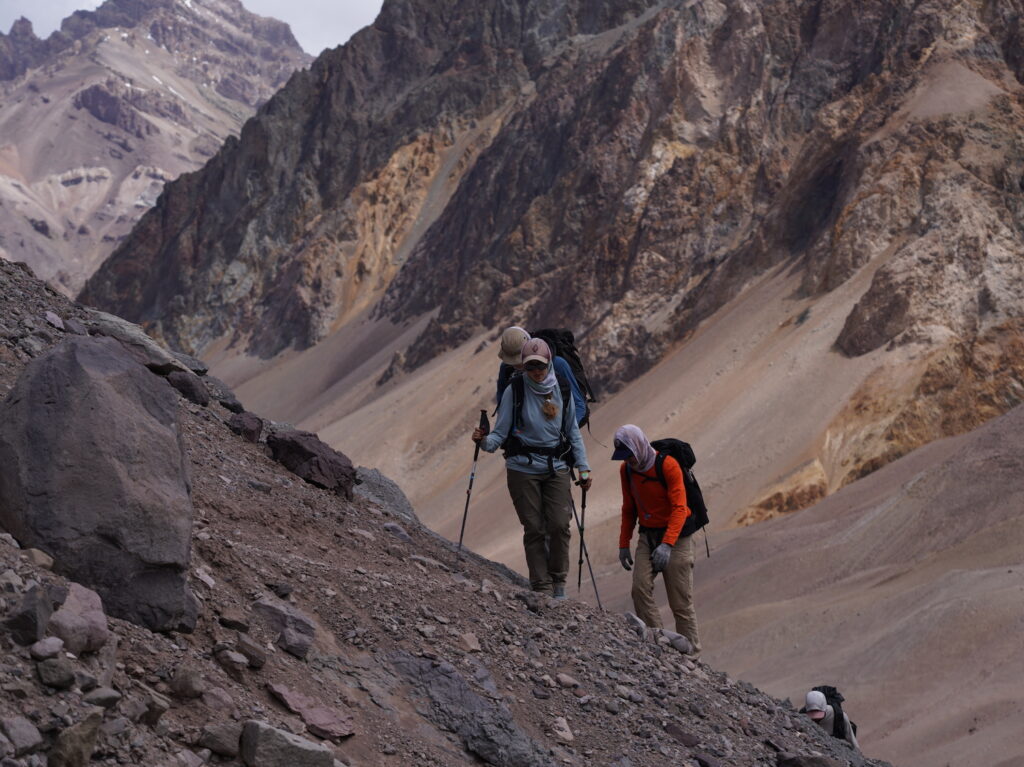
Footwear
- Double wall boots
- Lightweight trekking boots or shoes
- Camp sandals Liner socks (2x)
- Hiking socks (3x)
- Warm mountaineering socks (3x)
Personal Gear
- Expedition pack (70L)
- Alpine pack (35 L)
- Waterproof, durable duffel bags (2x)
- Hydration system
- Headlamp
- Prescription medications Sunscreen
- 3×1-liter water bottles with insulated sleeve covers
- Mess kit (cutlery, mug, bowl)
- Thermos
- Pocketknife
- Heavy-duty garbage bags
Our Recommended Guides: Benegas Brothers Expeditions (BBE)
I went to climb Mount Aconcagua with Benegas Brothers Expeditions (BBE) while working on a film project for their adventure filming company, Benegas Brothers Productions.
I can’t recommend BBE enough. Willie and Damian Benegas, the founders and lead guides, have been climbing Aconcagua since the late 1980s and were among the original pioneers guiding on the peak. They are extremely well respected on the mountain, and together, they’ve summited Aconcagua over 100 times. They also have a lengthy professional climbing and guiding career around the world, including 20 collective Everest summits, speed records in Yosemite Valley, numerous Seven Summits expeditions, and more.
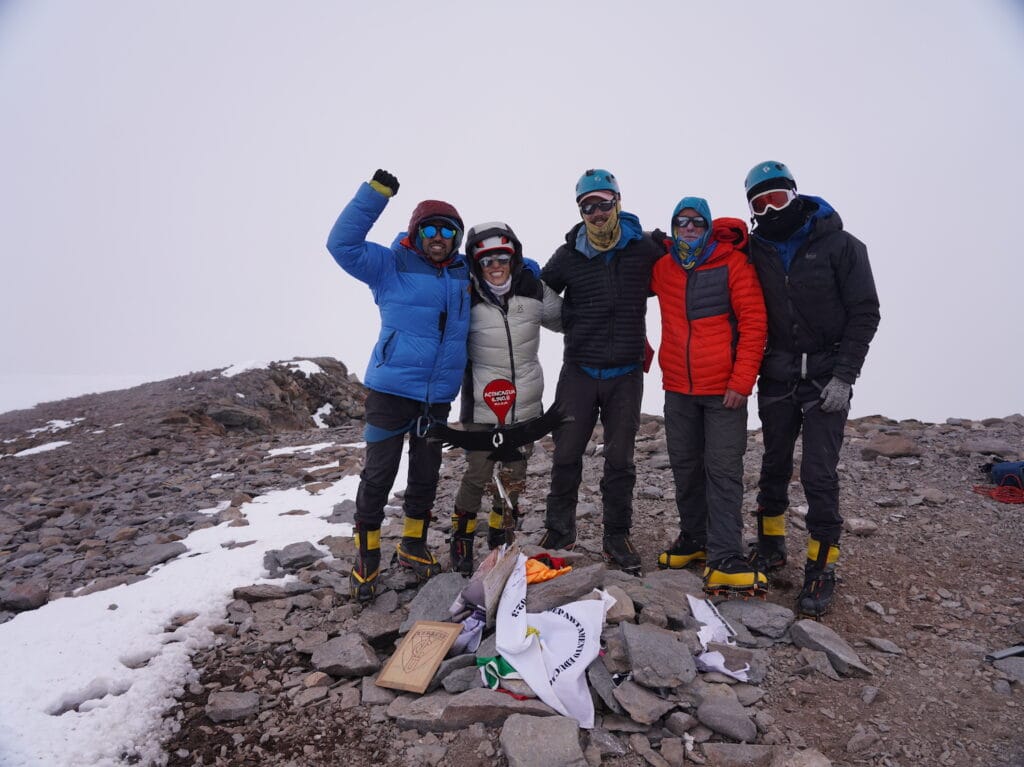
What’s more, Benegas Brothers Expeditions offers intimate, small-footprint expeditions. Overall group sizes and guide-to-client ratios are small, so you’ll have firsthand experience climbing with these world-renowned guides. Their Aconcagua expedition plan (linked below) also allows for excellent acclimatization, and you get the opportunity to summit four non-technical peaks before you even get on the mountain! These are Lomas Blancas (12,631 feet), El Estudiante (12,795 feet), Caucaso (13,287 feet), and Adolfo Calle (14,107 feet).
Learn more about climbing Aconcagua with Benegas Brothers Expeditions on their website HERE
Aconcagua Climbing Schedule
The following is a basic itinerary of a 20-day Aconcagua climb via the Normal Route. Some itineraries are much shorter, but a longer schedule, like the one below, helps with proper acclimatization and will reduce your risk of developing acute mountain sickness (AMS).
| Day | Activity |
|---|---|
| Day 1 | Arrive in Mendoza |
| Day 2 | Drive from Mendoza to the Vallecitos Valley |
| Days 3-6 | Acclimatization hiking in the Vallecitos Valley |
| Day 7 | Transfer to Aconcagua trailhead, then hike to Confluencia Camp (11,200 feet) |
| Day 8 | Trek from Confluencia Camp to Aconcagua Base Camp (Plaza de Mulas at 14,300 feet) |
| Day 9 | Rest day at Base Camp/Plaza de Mulas |
| Day 10 | Carry loads from Base to Camp I (Plaza Canadá at 16,500 feet) and return to Base Camp to sleep |
| Day 11 | Move to Camp I |
| Day 12 | Move to Camp II (Nido de Cóndores at 18,300 feet) |
| Day 13 | Rest Day |
| Day 14 | Move to Camp III (Plaza Colera at 19,500 feet) |
| Day 15 | Summit Day! |
| Day 16 | Descend to Base Camp |
| Days 17-18 | Backup days at high camps (in case of poor weather conditions) |
| Day 19 | Trek out from Base Camp and travel to Mendoza |
| Day 20 | Return home |
Frequently Asked Questions
Can a beginner climb Aconcagua?
A beginner can certainly climb Aconcagua via the Normal Route during optimal conditions. No technical ice or rock climbing is required, and (depending on weather conditions) some parties don’t even use axes or crampons. However, Aconcagua is a high altitude peak and very physically demanding. Reaching the summit requires strong physical condition, with extremely good cardiovascular health.
How hard is it to climb Aconcagua?
Although Aconcagua is non-technical, and thus easier than most peaks of a similar elevation, it is a serious physical undertaking. Extreme altitude, cold temperatures, and high winds can make this South American peak very tough. The mountain environment is harsh and unforgiving. Almost every climber will deal with altitude sickness to some degree, and climbers need to be in top physical shape to reach the summit. There is also potential for deep snow, although generally the mountain is quite dry during peak season.
How hard is Aconcagua compared to Kilimanjaro?
Neither peak requires technical climbing, but Aconcagua is significantly harder than Kilimanjaro. It is 3,500 feet higher, generally much colder, and most sections are quite a bit steeper than anything you’ll encounter on Kilimanjaro. For perspective, on Aconcagua summit day (the hardest day of the expedition), you’ll begin from high camps at an elevation above the summit of Kilimanjaro, and still need to climb over 3,000 feet to the top.

How long does it take to climb Aconcagua?
Most expeditions take between 16 and 20 days to climb Aconcagua, in total. However, the climbing portion itself (from the park entrance to the summit) only takes most groups 8 to 10 days. If flying into Argentina from a foreign country, plan for a total trip of approximately 20 days. This includes a couple of nights in Mendoza on each end, travel days, rest days, and a few days of acclimatization outside the park. Some outfitters offer much shorter trips (around 12 days). These can save time and money but include less time to let your body adjust to high altitudes, so they come with an increased risk of poor acclimatization and altitude sickness.
References
Aconcagua (retrieved on 03/01/2023)
Wikipedia
https://en.wikipedia.org/wiki/Aconcagua
Parque Provincial Aconcagua (Spanish, retrieved on 03/02/2023)
Mendoza Gobierno
https://www.mendoza.gov.ar/aconcagua/

Mr. Clarke, thank you for the informative specs on climbing Aconcagua. I’ve set my sights on January 2024. Biggest hurdle currently is which company to climb with.
If you have a moment and would be gracious enough to give further insight into your experience on the mountain, I would be most grateful. Doing my research online, there appears to be conflicting reviews on many details to plan for and who to choose.
Best Regards
Dave DeVito
Hi David, we would recommend using Benegas Brothers Expeditions, which is the company Owen used. If they have no availability, they should still be able to recommend another great guide for your climb. Let us know how it goes!
Best,
Kevin